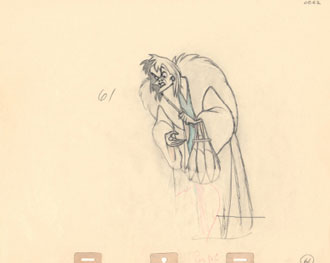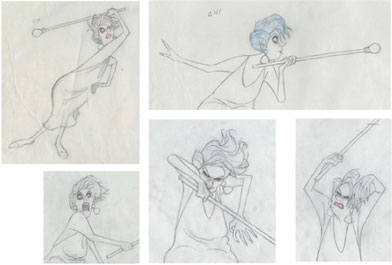The ability to animate is akin to the ability to act. Animation is, in effect, acting on paper. This doesn’t mean an animator must be able to act well on stage or before a camera, but that he must certainly be sensitive to poses and gestures that portray the various moods and emotions that story telling demands. After all, any poses that are chosen for the different phases of an action must serve the function of telling the story in a convincing and entertaining manner.
The animator must portray the character’s actions and reactions, their wildest feelings, and their subtlest moods. Whether the character is animal, human, or an inanimate object, the action must be caricatured beyond what might have been done in live action, although never beyond the limits of good taste.
Drapery too must be caricatured, and though it may have to be handled independently, it must not work independently. That is, it must relate to the action, or if not moving, must relate to the pose.
Posing for mood or character may be enhanced by the use of symbols (see the chapter Symbols for Poses). Study the model sheet on the next page for Madame Medusa from The Rescuers. She is constantly in contorted poses that form diagonals and twisted spirals, her fingers are restless and tense, her arms form triangles and warped spares. The shape from her hips to her knock knees, to her feet, form an hour glass — something you’ll find on the belly of any female black widow spider.

Cruella de Vil from 101 Dalmations.
Study Madame Medusa from The Rescuers. Restlessness is in her very character, diagonals are her very structure.
The movement from one pose to another is also important. Certainly, a person in a serene mood will not move jerkily or menacingly. Likewise a person whose life is in danger will not waltz from one dungeon window to another to see if the man with the axe has arrived.
Once a mood has been established, it must be maintained until there is reason for it to change, and when the mood does change, it must be definite. An audience likes to be held in suspense in a murder mystery, but it doesn’t like the insecure feeling of not knowing a character’s mood. As a matter of fact, they are flattered when they can detect moods or even anticipate them. In music, most people like a definite beat. They know what’s coming, they know what to expect, and they can count on it. Take away the beat, they feel unstable. In cartoons, especially feature cartoons, take away the mood or the “beat,” and in its place go instability, plus unlikelihood, plus incredibility.
Alice in Wonderland thrived on sporadic mood changes. Alice is constantly thrown off balance, but the audience isn’t, because they know these changes are in themselves the very humor the story is telling.

